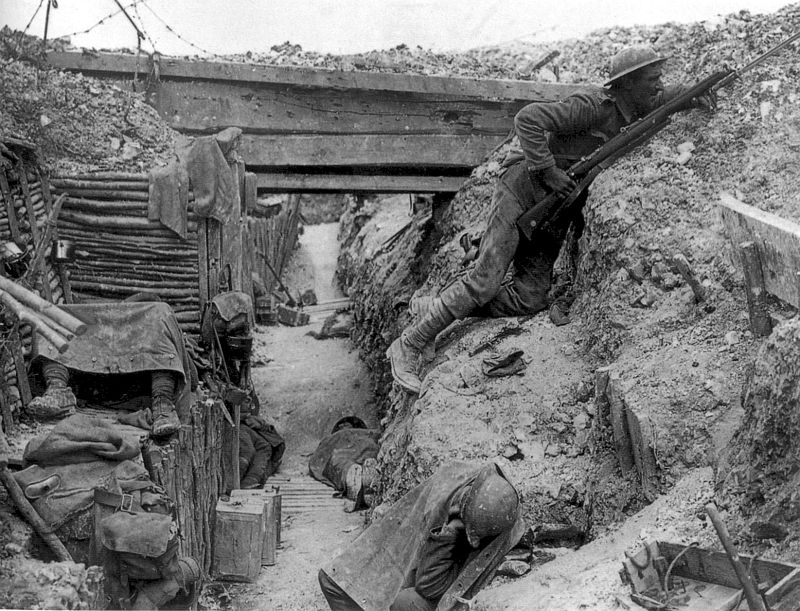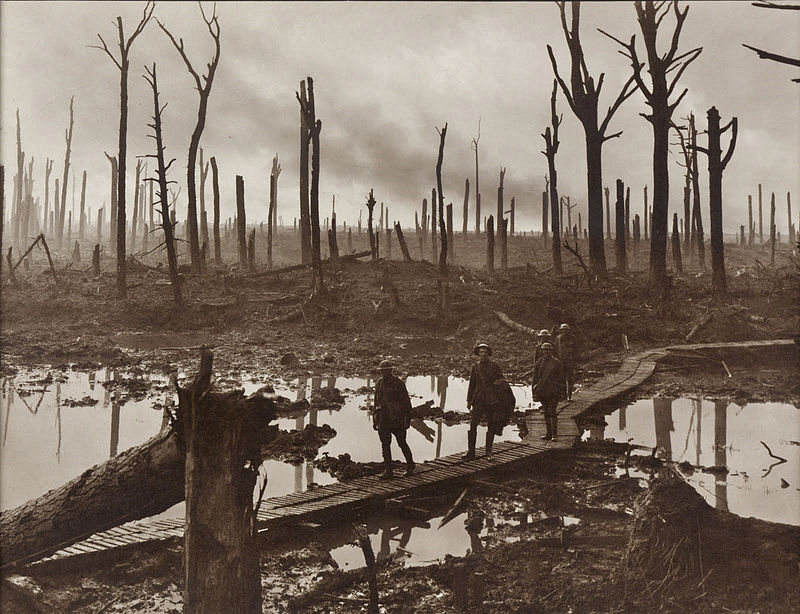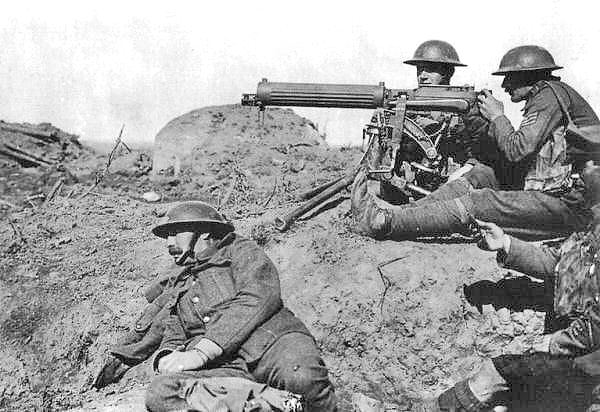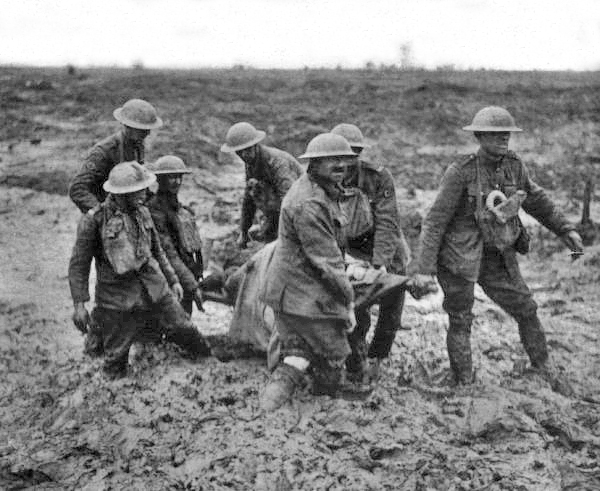“The most appalling atrocity story” of World War I according to some. Stories were circulated that the Germans had introduced a new way of ‘recycling’ the dead bodies that were piling up on the front. ‘The German Corpse Factory’ is one of the most famous and scandalous propaganda stories of the First World War. It has been repeated many times down to the present day as an example of the falsehood of British wartime propaganda. But despite all the attention paid to it, the full story has never been properly told.
Rumours that the Germans used the bodies of their soldiers to create fat appear to have been circulating by 1915. Cynthia Asquith noted in her diary on 16 June 1915: “We discussed the rumour that the Germans utilise even their corpses by converting them into glycerine with the by-product of soap.” Such stories also appeared in the American press in 1915 and 1916. The French press also took it up in Le Gaulois, in February 1916. In 1916, a book of cartoons by Louis Raemaekers was published. One depicted bodies of German soldiers being loaded onto a cart in neatly packaged batches. This was accompanied along with a comment authored by Horace Vachell: “I am told by an eminent chemist that six pounds of glycerine can be extracted from the corpse of a fairly well nourished Hun… These unfortunates, when alive, were driven ruthlessly to inevitable slaughter. They are sent as ruthlessly to the blast furnaces. One million dead men are resolved into six million pounds of glycerine.” A later cartoon by Bruce Bairns father also referred to the rumour, depicting a German munitions worker looking at a can of glycerine and saying “Alas! My poor Brother!”.
By 1917, the British and their allies were hoping to bring China into the war against Germany. On 26 February 1917, the English-language North-China Daily News published a story that the Chinese President Feng Guozhang had been horrified by Admiral Paul von Hintze’s attempts to impress him when the “Admiral triumphantly stated that they were extracting glycerine out of dead soldiers!”. The story was picked up by other papers.
In all these cases the story was told as rumour, or as something heard from people supposed to be in the know. It was not presented as documented fact.
The first English language accounts of a real and locatable Kadaververwertungsanstalt appeared in the 17 April 1917 editions of The Times and The Daily Mail (both owned by Lord Northcliffe at the time), The Times running it under the title Germans and their Dead. The editorial introduction said that it came from the Belgian newspaper l’Indépendance Belge published in England, which in turn had received it from La Belgique, another Belgian newspaper published in Leyden, The Netherlands, and that it had originally appeared in the 10 April 1917 edition of the German newspaper Berliner Lokal-Anzeiger. The original German newspaper story was presented as proof that the Germans were indeed rendering the bodies of their soldiers. It made no reference to the corpses being human, however the Belgian newspaper did. The German newspaper account was a very brief story by reporter Karl Rosner, only 59 words in length, which described the bad smell coming from a “kadaver” rendering factory. The Belgian account had been extended to over 500 words, and interpreted the word “kadaver” as a reference to human corpses.
The story described how corpses arrived by rail at the factory, which was placed “deep in forest country” and surrounded by an electrified fence, and how they were rendered for their fats which were then further processed into stearin (a form of tallow). It went on to claim that this was then used to make soap, or refined into an oil “of yellowish brown colour”. The supposedly incriminating passage in the original German article was translated in the following words:
We pass through Evergnicourt. There is a dull smell in the air, as if lime were being burnt. We are passing the great Corpse Utilization Establishment (Kadaververwertungsanstalt) of this Army Group. The fat that is extracted here is turned into lubricating oils, and everything else is ground down in the bones mill into a powder, which is used for mixing with pigs’ food and as manure.
A debate followed in the pages of The Times and other papers. The Times stated that it had received a number of letters “questioning the translation of the German word Kadaver, and suggesting that it is not used of human bodies. As to this, the best authorities are agreed that it is also used of the bodies of animals.” Letters were also received confirming the story from Belgian and Dutch sources and later from Romania.
It was a serious matter in the British press. A series of extracts are from The Times.
The Times ran this story in 1917:
One of the United States consuls, on leaving Germany in February 1917, stated in Switzerland that the Germans were distilling glycerine from the bodies of their dead.
The Times, April 16, 1917
Herr Karl Rosner, the Correspondent of the Berlin Lokalanzeiger, on the Western front … published last Tuesday the first definite German admission concerning the way in which the Germans use dead bodies.
We pass through Everingcourt. There is a dull smell in the air as if lime were being burnt. We are passing the great Corpse Exploitation Establishment (Kadaververwertungsanstalt) of this Army Group. The fat that is won here is turned into lubricating oils, and everything else is ground down in the bone mill into a powder which is used for mixing with pig’s food and as manure-nothing can be permitted to go to waste.
The Times, April 16, 1917
There was a report in The Times of April 17, 1917 from La Belgique (Leyden), via l’Indépendance Belge, April 10, giving a very long and detailed account of a Deutsche Abfallverwertungsgesellschaft [German Refuse Processing Company] factory near Coblenz, where train-loads of the stripped bodies of German soldiers, wired into bundles, arrive and are simmered down in cauldrons, the products being stearine and refined oil.

In The Times of April 18, 1917, there was a letter from C.E. Bunbury commenting and suggesting the use of the story for propaganda purposes, in neutral countries and the East, where it would be especially calculated to horrify Buddhists, Hindus, and Mohammedans. He suggested broadcasting by the Foreign Office, India Office, and Colonial Office; there were other letters to the same effect on April 19th.
In The Times of April 20, 1917, there was a story told by Sergeant B_____, of the Kents, that a prisoner had told him that the Germans boil down their dead for munitions and pig and poultry food. “This fellow told me that Fritz calls his margarine ‘corpse fat’ because they suspect that’s what it comes from.”
The Times stated that it had received a number of letters “questioning the translation of the German word Kadaver, and suggesting that it is not mean human bodies. As to this, the leading authorities are agreed that it is also used for the bodies of animals.” Other letters were received confirming the story from Belgian and Dutch sources and later from Roumania.
There was an article in the Lancet discussing the “business aspect” (or rather the technical one) of the industry. An expression of horror appeared from the Chinese Minister in London, and also from the Maharajah of Bikanir, in The Times of April 21, 1917.
The Times of April 23, 1917, quotes a German statement that the report is “loathsome and ridiculous,” and that [the term] Kadaver is never used of a human body. The Times produces dictionary quotations to show that it is. Also that both Tierkörpermehl and Kadavermehl appear in German official catalogs, the implication being that they must be something different.
In The Times of April 24, 1917, there was a letter, signed E.H. Parker, enclosing copy of the North China Herald, March 3, 1917, recounting an interview with the German Minister and the Chinese Premier in Pekin:
But the matter was clinched when Admiral von Hinke was discussing the ingenious methods by which German scientists were obtaining the chemicals necessary for the manufacture of munitions. The Admiral triumphantly stated that they were extracting glycerine out of their dead soldiers! From that moment onward the horrified Premier had no more use for Germany, and the business of persuading him to turn against her became comparatively easy.

SOME OPINIONS ON THE STORY
The following opinions on the German “Corpse Factory” story have been given by the prominent politicians named:—
Mr. D. Lloyd George.
The story came under my notice in various ways at the time. I did not believe them; I do not believe it now. It was never adopted as part of the armoury of the British Propaganda Department. It was in fact “turned down” by that department.
Mr. C. F. G. Masterman.
We certainly did not accept the story as true, and I know nobody in official positions at the time who credited it. Nothing suspect as this was made use of in our propaganda. Only such information as had been properly verified was circulated.
Mr. Ian Macpherson.
I was at the War Office at the time. We had no reason to doubt the authenticity of the story when it came through. It was supported by the captured divisional orders of the German army in France and I have an impression it was also backed up by the Foreign Office on the strength of extracts from the German press. We did not know it had been invented by anybody and had we known there was the slightest doubt about the truth of the story it would not have been used in any way by us.
On 11th May, 1917, the German Foreign Secretary, Arthur Zimmerman, told the Reichstag: “No reasonable person among our enemies can have been in any uncertainty about the fact that this has to do with the bodies of animals and not of human beings. The fact that the word cadavre in French is used for human beings and animals has been exploited by our enemies. We have rectified this subtle misunderstanding, which, against its better knowledge, has been used by the enemy press to mislead public opinion. In neutral countries, in so far as there is a tangible slanderous intention, criminal proceedings will be taken.”
The British public continued to believe the German corpse factory story. However, in 1924, Bertrand Russell argued in an essay on propaganda, Those Eventful Years, that the story was released in China when the nation’s participation in the First World War was required: “Worldwide publicity was given to the statement that the Germans boiled down human corpses in order to extract from them gelatine and other useful substances… The story was set going cynically by one of the employees in the British propaganda department.”

The following year Brigadier-General John Charteris admitted that he invented the story when he was visiting New York City. It was reported in the New York Times that he gave a speech at a private dinner function at the National Arts Club. He admitted that he had provided false information to government ministers when they were asked questions about it in the House of Commons. Charteris went onto say: “The matter might have gone even further, for an ingenious person in his office offered to write a diary of a German soldier, telling of his transfer from the front after two years of fighting to an easy berth in a factory, and of his horror at finding that he was to assist there in boiling down his brother soldiers. He obtained a transfer to the front and was killed. It was planned to place this forged diary in the clothing of a dead German soldier and have it discovered by a war correspondent who had a passion for German diaries. General Charteris decided that the deception had gone far enough and that there might be an error in the diary which would have led to the exposure of the falsity.”
The speech was reported in London and Charteris was forced to issue a statement: “I feel it, therefore, necessary to give again a categorical denial to the statement attributed to me. Certain suggestions and speculations as regards the origin of the Kadaver story which have already been published in Those Eventful Years and elsewhere, which I repeated, are, doubtless unintentionally, but nevertheless unfortunately, turned into definite statements of fact and attributed to me. Lest there should still be any doubt, let me say that I neither invented the Kadaver story, nor did I alter the captions in any photograph, nor did I use any faked material for propaganda purposes. The allegations that I did so are not only incorrect, but absurd.”
The Times responded on 4th November 1925: “This paper makes the significant observation that in the course of his denial he offered no comment on his reported admission that he avoided telling the truth when questioned about the matter in the House of Commons, or on his own description of a scheme to support the Corpse Factory story by planting a forged diary in the clothing of a dead German prisoner – a proposal which he only abandoned lest the deception might be discovered.”
